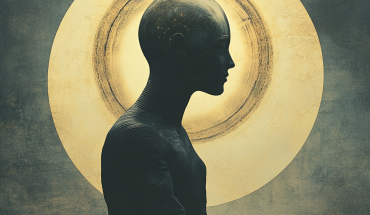In an earlier post I pointed out to one of my personal favorite suttas in the pali canon, Bahiyas instruction. While the story surrounding Bahiya is very exciting and the instruction the Buddha gave him summarizes the gist of vipassana very vividly in a couple of lines (a favorite passage many books on Buddhist meditation like to quote), there is one other place (and only one) in the Sutta-Pitaka where this exact same instruction was given -in another instance to another person.
It was Malunkyaputta whom the Buddha instructed in the same manner as Bahiya with that famous line “in the seen, there should only be the seen”.
Now this second source is highly valuable to understand and analyze one of the most quoted references to vipassana practice. Below you will find a copy of the pali text and my attempt (introductory parts are from Ven. Thanissaro’s translation) at a close translation – focusing on meaning and its application towards meditation, rather than readability.
This is the sutta:
2. Mālukyaputtasuttaṃ
Atha kho āyasmā mālukyaputto [māluṅkyaputto (sī.)] yena bhagavā tenupasaṅkami…pe… ekamantaṃ nisinno kho āyasmā mālukyaputto bhagavantaṃ etadavoca – ‘‘sādhu me, bhante, bhagavā saṃkhittena dhammaṃ desetu, yamahaṃ bhagavato dhammaṃ sutvā eko vūpakaṭṭho appamatto ātāpī pahitatto vihareyya’’nti.
Then Ven. Malunkyaputta went to the Blessed One and, on arrival, having bowed down to him, sat to one side. As he was sitting there, he said to the Blessed One: “It would be good, Lord, if the Blessed One would teach me the Dhamma in brief so that, having heard the Dhamma from the Blessed One, I might dwell alone, in seclusion, heedful, ardent, & resolute.”
‘‘Ettha dāni, mālukyaputta, kiṃ dahare bhikkhū vakkhāma! Yatra hi nāma tvaṃ, bhikkhu, jiṇṇo vuddho mahallako addhagato vayoanuppatto saṃkhittena ovādaṃ yācasī’’ti.
“Here now, Malunkyaputta: What will the young monks say when you — aged, old, elderly, along in years, come to the last stage of life — ask for an admonition in brief?”
‘‘Kiñcāpāhaṃ, bhante, jiṇṇo vuddho mahallako addhagato vayoanuppatto. Desetu me, bhante , bhagavā saṃkhittena dhammaṃ, desetu sugato saṃkhittena dhammaṃ, appeva nāmāhaṃ bhagavato bhāsitassa atthaṃ ājāneyyaṃ. Appeva nāmāhaṃ bhagavato bhāsitassa dāyādo assa’’nti.
“Lord, even though I’m aged, old, elderly, along in years, come to the last stage of life, may the Blessed One teach me the Dhamma in brief! May the One Well-gone teach me the Dhamma in brief! It may well be that I’ll understand the Blessed One’s words. It may well be that I’ll become an heir to the Blessed One’s words.”
‘‘Taṃ kiṃ maññasi, mālukyaputta, ye te cakkhuviññeyyā rūpā adiṭṭhā adiṭṭhapubbā, na ca passasi, na ca te hoti passeyyanti? Atthi te tattha chando vā rāgo vā pemaṃ vā’’ti? ‘‘No hetaṃ, bhante’’.
“What do you think, Malunkyaputta: the forms cognizable via the eye that are unseen by you — that you have never before seen, that you don’t see, and that are not to be seen by you: Do you have any desire or passion or love there?” – “Varily no, Sir”
‘‘Ye te sotaviññeyyā saddā assutā assutapubbā, na ca suṇāsi, na ca te hoti suṇeyyanti? Atthi te tattha chando vā rāgo vā pemaṃ vā’’ti? ‘‘No hetaṃ, bhante’’.‘‘Ye te ghānaviññeyyā gandhā aghāyitā aghāyitapubbā, na ca ghāyasi, na ca te hoti ghāyeyyanti? Atthi te tattha chando vā rāgo vā pemaṃ vā’’ti? ‘‘No hetaṃ, bhante’’.‘‘Ye te jivhāviññeyyā rasā asāyitā asāyitapubbā, na ca sāyasi, na ca te hoti sāyeyyanti? Atthi te tattha chando vā rāgo vā pemaṃ vā’’ti? ‘‘No hetaṃ, bhante’’. ‘‘Ye te kāyaviññeyyā phoṭṭhabbā asamphuṭṭhā asamphuṭṭhapubbā, na ca phusasi, na ca te hoti phuseyyanti? Atthi te tattha chando vā rāgo vā pemaṃ vā’’ti? ‘‘No hetaṃ, bhante’’.
“The sounds cognizable via the ear…
“The aromas cognizable via the nose…
“The flavors cognizable via the tongue…
“The tactile sensations cognizable via the body…
‘‘Ye te manoviññeyyā dhammā aviññātā aviññātapubbā, na ca vijānāsi, na ca te hoti vijāneyyanti? Atthi te tattha chando vā rāgo vā pemaṃ vā’’ti? ‘‘No hetaṃ, bhante’’.
“The ideas cognizable via the intellect that are uncognized by you — that you have never before cognized, that you don’t cognize, and that are not to be cognized by you: Do you have any desire or passion or love there?” “Varily no, Sir!”
‘‘Ettha ca te, mālukyaputta, diṭṭhasutamutaviññātabbesu dhammesu diṭṭhe diṭṭhamattaṃ bhavissati, sute sutamattaṃ bhavissati, mute mutamattaṃ bhavissati, viññāte viññātamattaṃ bhavissati.
And here to you, Malunkyaputta, with regard to all seen, heard, felt and cognized objects – in the seen should just be the seen, in the heard just be the heard, in the felt just be the felt, in the cognized just be the cognized.
Yato kho te, mālukyaputta, diṭṭhasutamutaviññātabbesu dhammesu diṭṭhe diṭṭhamattaṃ bhavissati, sute sutamattaṃ bhavissati, mute mutamattaṃ bhavissati, viññāte viññātamattaṃ bhavissati; tato tvaṃ, mālukyaputta, na tena. Yato tvaṃ, mālukyaputta, na tena; tato tvaṃ, mālukyaputta, na tattha. Yato tvaṃ, mālukyaputta, na tattha; tato tvaṃ, mālukyaputta, nevidha, na huraṃ, na ubhayamantarena. Esevanto dukkhassā’’ti.
When now to you, Malunkya, with regard to seen-heard-felt-cognized objects in the seen just the seen will be….in the cognized just the cognized will be – Then, Bahiya, you will not be with it. If you are not with it, Bahiya, you will not be there. If you are not there, Bahiya, then you are neither here nor there nor in between both ends. This indeed is the end of suffering.
Now in order to demonstrate how he understood the Buddha, Malunkyaputta details what we need to do in order to see “in the seen just the seen” and “in the heard only the heard” and in the “cognized only the cognized”. This, if you will, is the authentic “Power IN the now” and – feeling like a heart surgeon looking at the open heart of Buddhism, this is all we would ever need in order to capture its essence.
‘‘Imassa khvāhaṃ, bhante, bhagavatā saṃkhittena bhāsitassa vitthārena atthaṃ ājānāmi –
“I understand in detail, lord, the meaning of what the Blessed One has said in brief:
‘‘Rūpaṃ disvā sati muṭṭhā, piyaṃ nimittaṃ manasi karoto;
Sārattacitto vedeti, tañca ajjhosa [ajjhosāya (sī.)] tiṭṭhati.
‘‘Tassa vaḍḍhanti vedanā, anekā rūpasambhavā;
Abhijjhā ca vihesā ca, cittamassūpahaññati;
Evaṃ ācinato dukkhaṃ, ārā nibbānamuccati.
Having seen a form, lost remembering [ones meditation object],
A mind enthralled feels, and this (form) he grasps (lit. stands on as support)
For such a one feelings grow, various and initiated by form;
Greed and Anger will beat up his mind
Thus suffering will be heaped up, far is he from Nibbana it is said
…[the same is repeated for all other sense impressions]
Finally comes the part describing the ancient insight meditation exercise. Now we know from previous posts that this perception of impermanence (aniccasaññī) or suffering (dukkhasaññī) or non-self / emptiness (anattasaññī) will eventually jump start a process of nibbidā which will lead to a viraga which in turn will make the mind let go when nirodha occurs.
The question this sutta solves is the “how do we create such an aniccasaññā”?
Taking your favorite object of concentration as the starting point, you would start to “note/label” whatever (!) your mind would turn to. That could be a form, a sound, a taste, a smell, a body-touch-related feeling, a thought.
Quickly you would note whatever would present itself to your mind and you would turn immediately around back to your concentration object. The concentration should be good already so that your noting / sati will be strongly established (upatthāna). Otherwise you will be lost shortly in a wave of sense impressions. In any case, (very similar when one starts to practice any form of samatha, long before reaching an “abiding” in the jhanas) it takes quite a while before such an exercise of noting becomes routine and turns from a very labor intensive “manual” exercise into a … yes, you got it, into a “saññā” (perception – it turns into a real-time mode of observation), in this case an anicca-saññā if impermanence is the main characteristic of focus.
Again, this is not about “reflection” not about “mental theorizing” not about “contemplation” (which imply all forms of wild, random, trains of thought). Rather, what will be established by such an exercise within a couple of weeks / months, is a “mode of direct vision” a yathābhuta-ñānadassana which by definition will lead to nibbida:
‘‘Na so rajjati rūpesu, rūpaṃ disvā paṭissato;
Virattacitto vedeti, tañca nājjhosa tiṭṭhati.
‘‘Yathāssa passato rūpaṃ, sevato cāpi vedanaṃ;
Khīyati nopacīyati, evaṃ so caratī sato;
Evaṃ apacinato dukkhaṃ, santike nibbānamuccati.
He does not delight in forms, having seen a form he re-members (lit. returns to his remembering [a meditation object as anchor point, for example his breath, see below].(**)
With a dispassionate mind he feels, and does not grasp (does not rest) on this form.
It falls away, does not amass, thus he practices remembering/witnessing.
Thus suffering is reduced, and close is he to the blowing-out (Nibbana), they say.
…
The translation of “paṭissato” begs for some clarifying remarks. IMHO, this term too is crucial towards a better understanding of the practice of insight meditation as described in these early pali texts. If you compare general translations they have little to say on this word…many simply translate it as a synonym for “sato” and thus say again “mindful”. To most people it does not make any sense why suddenly sati is combined with the prefix “pati” which in pali means “back” or is used reflexive.
However, if you have been practicing yourself some form of vipassana or insight meditation you might remember (LOL) that in the process of your meditation you had to continously bring back your attention (your manasikara) which went to the “just” arisen “object” -whatever that may be. This is quite different from an approach in samatha meditation where your object suppresses the five senses. In the case of vipassana you allow for a miniscule attention off your concentration harboring object for the sake of a quick and decisive sharp look which however has to remain a look and stop the mind, bringing it back immediately in order to safeguard further proliferation which otherwise would immediately occur. This way you are able to look at the frames of the movie, not the content.
The further your progress, the more subtle stuff your mental microscope will notice – your attention which went to the womb (yoni) of the just arisen object – to wherever and whatever it has come into being (yatha-bhuta) – your attention which thus went to the source (yoniso manasikara) of each established sense contact (phassa) will then be re-directed BACK (paṭi-) to your main concentration object. While the zoom and scale of your microscope will be directly linked to the amount of concentration you are currently operating under it is clear that there IS some form of “returning to the focus of ones object which one tries to keep in mind” taking place. Exactly this little but essential part of the exercise as implied by “patissato” is described in the Mahasatipatthanasutta with the words:
Atthi kayo’ti panassa sati paccupatthita hoti yavadeva nanamattaya patissatimattaya
“There is a body” so too (using this note) is his remembering/noting/attention established, just for the sake of knowing (i.e. to gain insight, just to be aware of whatever object presented itself!) and for the sake of back-remembering (for the sake of getting quickly back to his meditation object as too keep the concentration up – this is what this “note” is used for).
Thus, my interpretation of “pati-ssato” tries to capture this integral part of vipassana.
Another small remark on “carati sato”. While it is true that it literally means “he walks sato” and is usually translated as “he walks mindful” it is strange while at the one hand we are looking at an extremely subtle description of observing the six senses (rather fast!) and then, out of the nothing, the verse closes “thus he walks mindful”. Seen in context “carati” while meaning a physical movement also carriers a connotation of “proceeding”, going forward”, i.e. “practice”. This now makes perfect sense in such a text like ours. Ven. Malunkyaputta concludes that we ought to persist and practice this mode of observation continuously. It emphasizes the fact that it is unlikely for most people to be called “near Nibbana” when they are able to only recognize form etc. in this manner for one moment.
As AN, 7 stated:
Idha, bhikkhave, ekacco puggalo sabbasaṅkhāresu aniccānupassī viharati, aniccasaññī, aniccapaṭisaṃvedī satataṃ samitaṃ abbokiṇṇaṃ cetasā adhimuccamāno paññāya pariyogāhamāno. So āsavānaṃ khayā…pe… sacchikatvā upasampajja viharati.
We need to practice our aniccānupassana always (satatam) samitam (without interruption) determined without interruptions by the mind (abbokiṇṇaṃ cetasā adhimuccamāno) with wisdom completely yoked to this exercise (paññāya pariyogāhamāno).
Good luck 🙂
 This sutta is one of the many which, if it would have been the only one to survive, would have been enough to re-discover “Buddhism” as intended by the Buddha.
This sutta is one of the many which, if it would have been the only one to survive, would have been enough to re-discover “Buddhism” as intended by the Buddha.
Anyway, if you are looking for some small sutta to learn by heart which explains vipassana in a direct and beautiful manner, this could definitely be one of your favorites…
PED Definition and some more passages with patissati:
Paṭissati (f.) [paṭi+sati of smṛ] mindfulness, remembrance, memory M i.36 sq.; Dhs 23; Pug 25. app˚ lapse of memory Dhs 1349.
‘‘Evaṃ khandhe avekkheyya, bhikkhu āraddhavīriyo; Divā vā yadi vā rattiṃ, sampajāno paṭissato.
‘‘Yo ca mettaṃ bhāvayati, appamāṇaṃ paṭissato; Tanū saṃyojanā honti, passato upadhikkhayaṃ.
‘‘Sabbe saṅkhārā aniccā’’ti … na parapaṭibaddhagū jānāti passati asammūḷho sampajāno paṭissato.
Punappunaṃ saratīti paṭissato.
Paṭissatoti paṭissatisaṅkhātāya satiyā yutto
(**)In fact, the English word re-members looks very much like pati-sati:
remember: c.1300, from O.Fr. remembrer (11c.), from L. rememorari “recall to mind, remember,” from re- “again” + memorari “be mindful of,” from memor “mindful”.
In this case pati-sati would literally imply some form of calling back into mind. Bringing our attention back to something.




